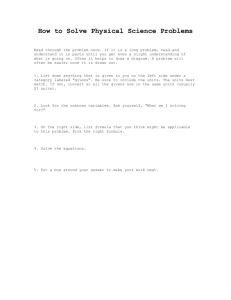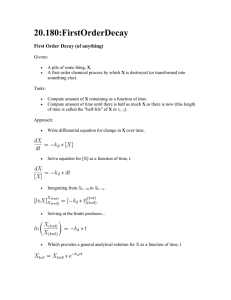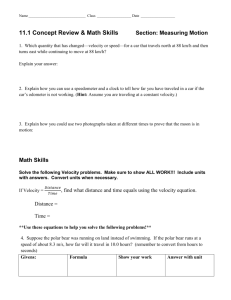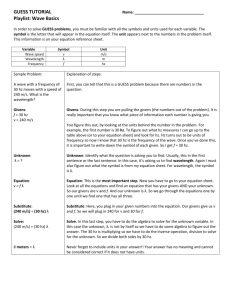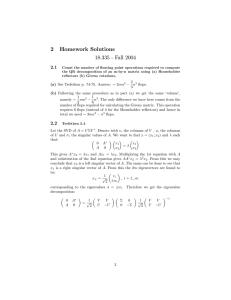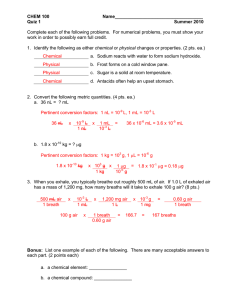Physics 153 Key for Chapter 26 Homework 2. Givens: R = 10 cm, IIn
advertisement
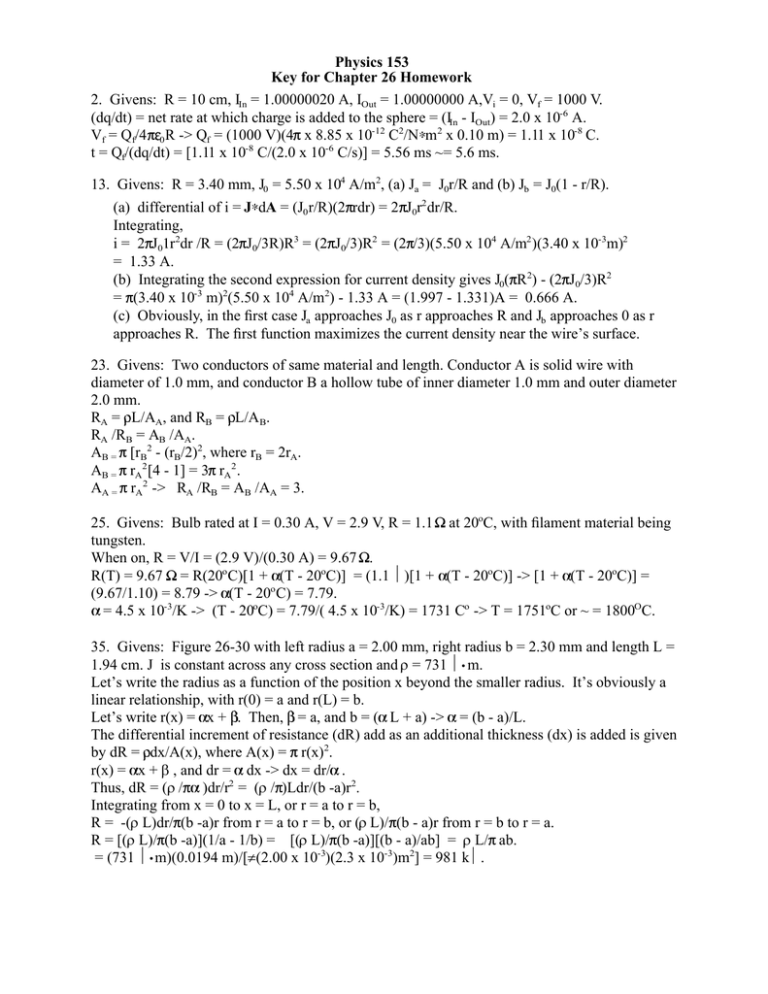
Physics 153 Key for Chapter 26 Homework 2. Givens: R = 10 cm, IIn = 1.00000020 A, IOut = 1.00000000 A,Vi = 0, Vf = 1000 V. (dq/dt) = net rate at which charge is added to the sphere = (IIn - IOut) = 2.0 x 10-6 A. Vf = Qf/4pe0 R -> Qf = (1000 V)(4p x 8.85 x 10-12 C2/N*m2 x 0.10 m) = 1.11 x 10-8 C. t = Qf/(dq/dt) = [1.11 x 10-8 C/(2.0 x 10-6 C/s)] = 5.56 ms ~= 5.6 ms. 13. Givens: R = 3.40 mm, J0 = 5.50 x 104 A/m2, (a) Ja = J0r/R and (b) Jb = J0(1 - r/R). (a) differential of i = J*dA = (J0 r/R)(2prdr) = 2pJ0r2 dr/R. Integrating, i = 2pJ01r2dr /R = (2pJ0/3R)R3 = (2pJ0/3)R2 = (2p/3)(5.50 x 104 A/m2 )(3.40 x 10-3m)2 = 1.33 A. (b) Integrating the second expression for current density gives J0(pR2) - (2pJ0/3)R2 = p(3.40 x 10-3 m)2(5.50 x 104 A/m2) - 1.33 A = (1.997 - 1.331)A = 0.666 A. (c) Obviously, in the first case Ja approaches J0 as r approaches R and Jb approaches 0 as r approaches R. The first function maximizes the current density near the wire’s surface. 23. Givens: Two conductors of same material and length. Conductor A is solid wire with diameter of 1.0 mm, and conductor B a hollow tube of inner diameter 1.0 mm and outer diameter 2.0 mm. RA = r L/AA, and RB = r L/AB. RA /RB = AB /AA. AB = p [rB2 - (rB/2)2, where rB = 2rA. AB = p rA2 [4 - 1] = 3p rA2 . AA = p rA2 -> RA /RB = AB /AA = 3. 25. Givens: Bulb rated at I = 0.30 A, V = 2.9 V, R = 1.1 Wat 20oC, with filament material being tungsten. When on, R = V/I = (2.9 V)/(0.30 A) = 9.67 W. R(T) = 9.67 W= R(20o C)[1 + a (T - 20oC)] = (1.1 Ω)[1 + a (T - 20oC)] -> [1 + a (T - 20oC)] = (9.67/1.10) = 8.79 -> a (T - 20o C) = 7.79. a = 4.5 x 10-3/K -> (T - 20oC) = 7.79/( 4.5 x 10-3/K) = 1731 Co -> T = 1751oC or ~ = 1800OC. 35. Givens: Figure 26-30 with left radius a = 2.00 mm, right radius b = 2.30 mm and length L = 1.94 cm. J is constant across any cross section and ρ = 731 Ω• m. Let’s write the radius as a function of the position x beyond the smaller radius. It’s obviously a linear relationship, with r(0) = a and r(L) = b. Let’s write r(x) = a x + b. Then, b = a, and b = (a L + a) -> a = (b - a)/L. The differential increment of resistance (dR) add as an additional thickness (dx) is added is given by dR = r dx/A(x), where A(x) = p r(x)2. r(x) = a x + β , and dr = a dx -> dx = dr/a . Thus, dR = (ρ /pa )dr/r2 = (ρ /p)Ldr/(b -a)r2. Integrating from x = 0 to x = L, or r = a to r = b, R = -(ρ L)dr/p(b -a)r from r = a to r = b, or (ρ L)/p(b - a)r from r = b to r = a. R = [(ρ L)/p(b -a)](1/a - 1/b) = [(ρ L)/p(b -a)][(b - a)/ab] = ρ L/p ab. = (731 Ω• m)(0.0194 m)/[π(2.00 x 10-3)(2.3 x 10-3)m2] = 981 kΩ. 37. Givens: Equation 19-31. Also, Equation 26-29 is r = m/e2nt . For any given metal, m and n are constant values, and of course e is a fundamental constant. The average time (t ) between collisions, is determined by the distance between atoms (which doesn’t change significantly over a range of several thousand degrees), and the average speed of the electrons. Equation 19-31 gives the average speed of the electrons as vavg = [8RT/pM]. All values in this equation are constant, except for the temperature T, and average speed. Thus, vavg varies as T1/2. The average time between collisions varies inversely with the average speed, so the resistivity r (which varies inversely with t ) varies directly as T1/2 . 52. Givens: Copper wire with A = 2.0 x 10-6 m2, length L = 4.0 m, J = constant = (I/A), with I = 2.0 A. (a) J = I/A = 1.0 x 106 A/m2 -> E = rJ = (1.69 x 10-8 W• m)(1.0 x 106 A/m2) = 1.7 x 10-2 V/m. (b) R = rL/A = (1.69 x 10-8 W• m)(4.0 m)/( 2.0 x 10-6 m2) = 3.38 x 10-2 W. P = I2R = (2.0 A)2(3.38 x 10-2 W) = 0.135 W. Energy = Pt = (0.135 W)(1800 s) = 243 J. 59. Givens: Power of nichrome heater is 500 W, when V is 110 V and T = 800o C, and for nichrome a = 4.0 x 10-4/K at 800oC = T2 . P = V2/R -> R = V2 /P = 24.2 Wat 800oC. Assume a is the same over the entrie range of temperatures. R(200o C) = R(800o C)[1 + a (200 - 800)Co] = (24.2 Ω )[1 + (4.0 x 10-4/K)(-600 Co)] = 0.76(24.2 W) = 18.4 W. P = V2/R(200oC) = (1102 /18.4)W = 658 W ~= 660 W.
